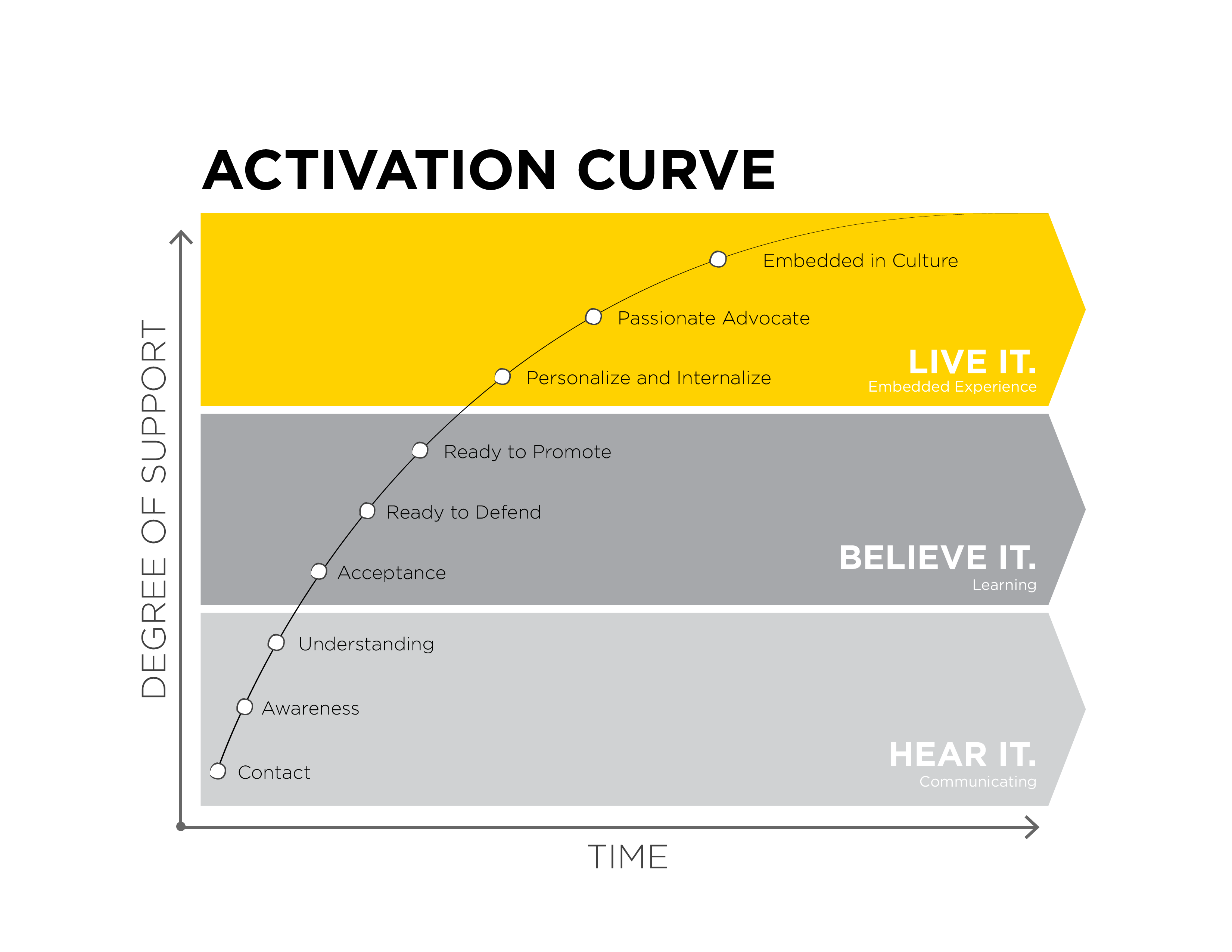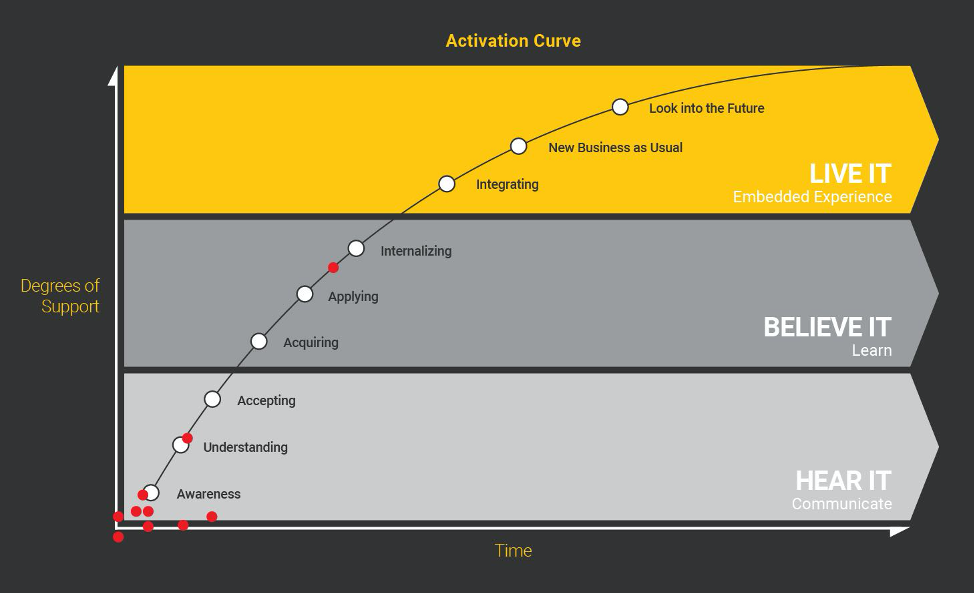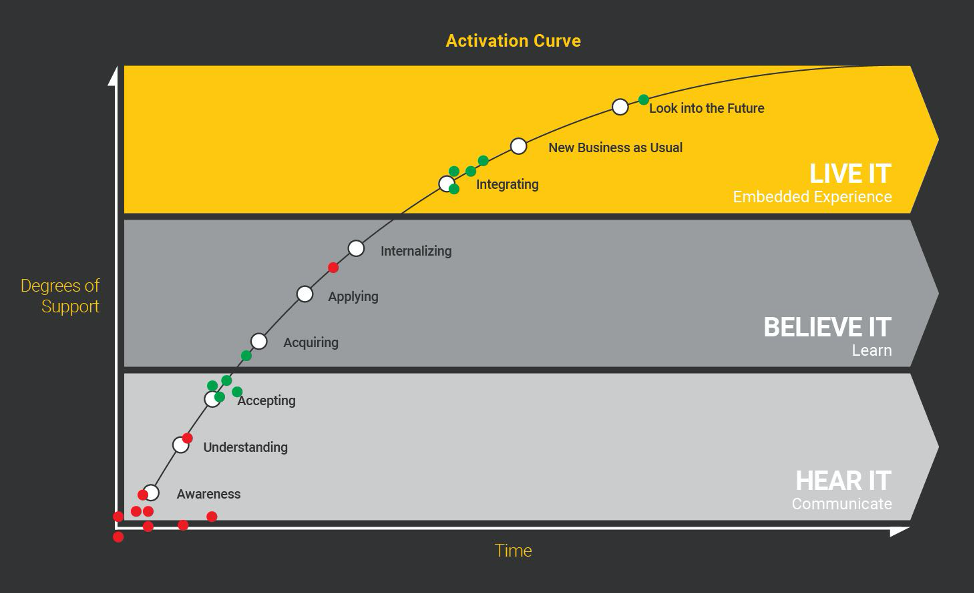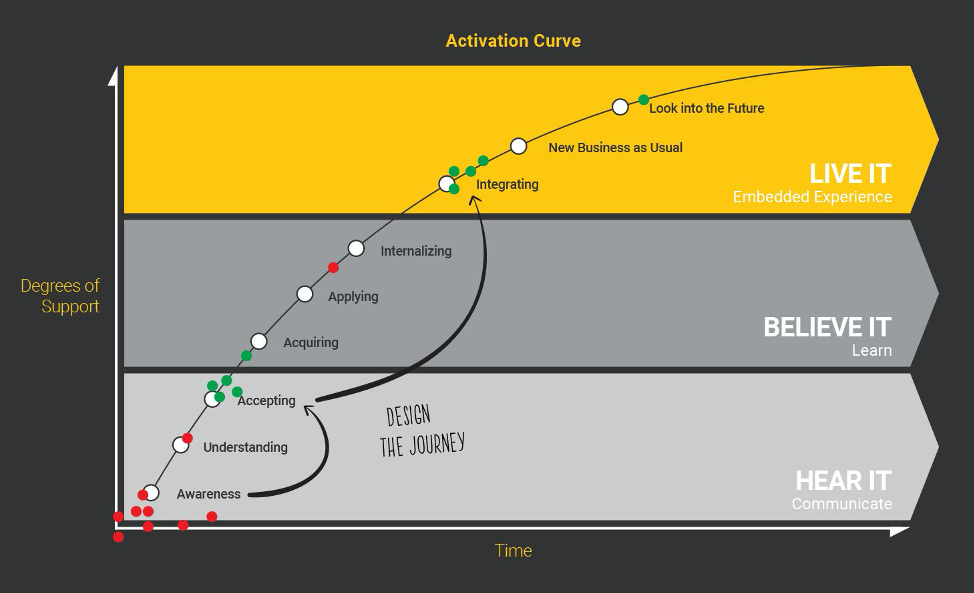After devoting hours of work hammering out a strategy to move your organization in the right direction, you’re ready to share your team’s plan with the company.
Jazzed to get things rolling, you craft a fantastic email to get the word out and post the brand-new strategy on the intranet.
Then you wait for things to happen.
No Time for Tomes
Sadly, you might have to wait a while because communication alone rarely makes change happen.
In fact, assuming people will snap to a new plan once they hear it is one reason 80% of strategies fail—no matter how well conceived your plan.
To really sow the seeds of change, people need help making sense of the more ambiguous points of your plan. They need to understand content that doesn’t quite connect.
They don’t need to read through pages of strategy to do this. They need a concrete starting point and tactics that will help them get on board with change.
Moving Up the Activation Curve
This is where strategy activation comes in.
Over the years, XPLANE has helped organizations large and small quickly diagnose the all-important starting point for change using a step-by-step Activation Curve exercise.
This process engages employees and connects them to solutions and tactics that move them up the Activation Curve—from hearing a new strategy, to believing it, and ultimately, to living it.

The Strategy Activation Exercise
Remember, it’s not enough to hear a strategy. People must start to believe it—and then they need a plan to live it.
This exercise will get you on your way.
First, gather essential materials and supplies.
To get started, you’ll need the following materials:
For a virtual meeting, you’ll need access to an online collaboration platform. XPLANE uses Mural.
For an in-person meeting, you’ll need two different colored self-adhesive dots (enough for each individual to have a pair of different colored dots) and pens or markers.
Next, set up for your session.
Once you’ve gathered your supplies, you’ll need to do a bit of prep work:
- Download or print the Activation Curve Poster.
For a virtual session, upload the poster to your digital whiteboard or draw the activation curve directly onto the digital whiteboard.
For an in-person session, you’ll want the poster to be at least 2’ by 3’—large enough for a group of 6 to 10 to see it from across a small room.
Alternatively, you could draw the activation curve on a whiteboard. Affix the poster to a wall, leaving enough room for a crowd of people to stand around it.
- Download or print the Building Blocks of Activation Worksheet.
For a virtual session, upload the worksheet to your digital whiteboard.
If you’re hosting an in-person session, you’ll need enough copies for each group or each member of the group.
Now it’s time to do the exercise.
To create a workable activation plan, you’ll need to assess as a group where you are, where you’re headed, and how you’ll get there. Make sure the group includes representatives of people impacted by this plan.
Here’s your step-by-step guide to making this happen.
Step 1: Align on the Current State
Assessing your organization’s current state—today’s level of understanding and support—will spark discussion about the group’s level of alignment and the organization’s degree of support.

Figure 1. Red dots on the Activation Curve indicate the current level of understanding and support.
Here’s how we break down this step at XPLANE:
Explain the goal. Example: “Our goal today is to understand where we are as an organization in respect to our strategy. We’re here to determine how to activate our strategy within the organization.”
Explain the process. Example: “We want to know where we think we are, where we need to be, and how much we have to do to get there.”
For a virtual session, ask participants to use a red circle or graphic on the digital whiteboard.
For an in-person session, provide each individual with one red dot.
Explain the exercise. Example: “Place one red dot or graphic on the Activation Curve where you think our organization is currently. As you place your dot or graphic, ask yourself some questions: Are most individuals aware of the strategy? Do they understand it? Do they accept it? Has it been rolled out?”
Discuss. Once everyone has placed a red dot or graphic on the poster, ask these questions:
- Are we aligned? If not, why?
- Can we come to a consensus on where to start?
- Pro tip: Advise people to be as honest as possible. For instance, if most participants think employees have just become aware of the strategy, that may carry enough weight to start. If most participants think one way, but someone has data to the contrary, weigh the data against the consensus.
Decide. Come to an agreement on where the organization or the audience for this strategy is at in understanding or supporting the strategy.
- Pro tip: A good rule of thumb is the 20/60/20 rule. About 20% of the audience may not care about or may just ignore a new strategy. Focusing effort on this group may be costly. About 20% of the audience will be committed and want to learn more; with this group, limited effort is required. Instead, focus on the 60% of the audience in the middle. While there are barriers to overcome, this group is open to change they can trust.
In Figure 1, let’s say 80% of employees are currently at awareness. You’ve sent emails, posted strategy goals in common areas, and created a landing page on your intranet. You believe most people are aware. Set your organization’s current state at Awareness.
Step 2: Align on the Future State
The future state on the Activation Curve is where you want your team or organization to go.
In determining your desired future state, you want to be aspirational but realistic. Every company wants their organization to immediately live their strategy or vision. However, if your timeframe is fairly limited, it might be more realistic to get people to simply to understand or accept the strategy. Remember that moving up the Activation Curve takes time, effort, and planning.
Using the process outlined in Step 1, determine the future state. Then ask the following questions:
How long do we have to achieve our desired future state?
Keep these things in mind:
- The less time you have, the fewer steps you can take.
- The larger the divide between current state and future state, the more time required. It can take years to go from Awareness to New Business as Usual.
- The larger your organization, the longer it takes to move up the Activation Curve.
- The more entrenched your organization is to current approaches, the more difficult it is to move up the Activation Curve. Inversely, the more adaptive your organization is to change, the easier it is to move up the Activation Curve.
Your organization may want to approach change as a multi-phase process. What can the organization accomplish within 6 months, 1 year, and 3 years?

Figure 2. Green dots on the Activation Curve indicate future level of understanding.
In Figure 2, the first goal is for most people to accept the strategy. Achieving full integration may be Phase 2.
- Pro tip: For now, focus on moving up two steps, from Awareness to Understanding and then to Acceptance. This may take a year depending on (1) how adaptive or entrenched your organization is, (2) the size of the group impacted by change, and (3) the complexity of the change.
Step 3: Design the Journey
Once you have mapped what your organization currently supports and what you hope your organization to someday support, you can design the experience using tactics that will move people up the curve to Accepting, Applying, and Integrating the strategy.
Tactics include any exercise, activity, engagement, or tool that engages individuals with aspects of the strategy. Each tactic aligns to either Hear It, Believe It, or Live It, or a combination of all three.

For additional tactics that move employees up the curve, read on.
For example, the email tactic only supports Hear It and resides within the “Sharing the Story” strategy listed in the Activation Building Blocks Worksheet below. Sending out an email simply communicates a message but does very little to teach or embed it.
The Activation Building Blocks Worksheet
The Activation Building Blocks Worksheet offers a full list of strategies and tactics to forward your message.
A quick way to assess the right experiences, this worksheet is great for a handful of participants. It lists strategies and tactics on a single page and quickly helps you assess your organization’s appetite for specific tactics against the activation level you need to attain.
How to use the worksheet:
- In a virtual session, ensure each individual or group has their own worksheet. For an in-person session, print out enough sheets per individual or per group.
- Consider the following question: What tactics can the organization commit to? Be realistic but push the group to go just a bit beyond their comfort level.
- If you use one sheet for the entire group, skip to #6. If you use two or more sheets, continue to the next step.
- Using a fresh sheet, discuss and mark the tactics that make the most sense for your organization.
- On the worksheet, each tactic is tagged with a light gray, gray, or yellow dot. The colors correspond to the categories of the Activation Curve (see worksheet): light gray dots indicate tactics used for Hear It, gray dots indicate tactics for Believe It, and yellow dots indicate tactics for Live It.
- Organize tactics by category by rewriting them in a spreadsheet or on stickies.
The resulting list of tactics by category is your rough activation plan.
To take your rough plan to the next stage, you’ll need to discuss timing, effort, resources, and audience.
You may need to revisit this plan further. Feel free to add to these tactics with additional activities and methods not listed on this worksheet.
The Power of a Meaningful Activation Plan
Don’t rely on a single point of contact, like an email announcement, to set your carefully honed strategy into motion.
Instead, take steps to engage with your audience. By helping people move up the Activation Curve, you’ll start to see your strategy come to life—and your coworkers looking forward to the next big change ahead.
Want to learn more about how to truly get your strategy off the ground? We recommend these resources by XPLANE’s CEO Aric Wood:
- Overcome Strategy Failure: Three Principles to Bring Your Strategy to Life
- Execute Strategy Responsibly: 8 Tactics to Get Strategy Right
- Practical Tools to Design a Strategy Activation Plan (webinar)
You can also visit the Insights and Learning pages on our website for free, downloadable templates, tools, and exercises, as well as affordable tools such as card decks in the XPLANE store.
Lastly, we’d love to get your feedback and ideas.
